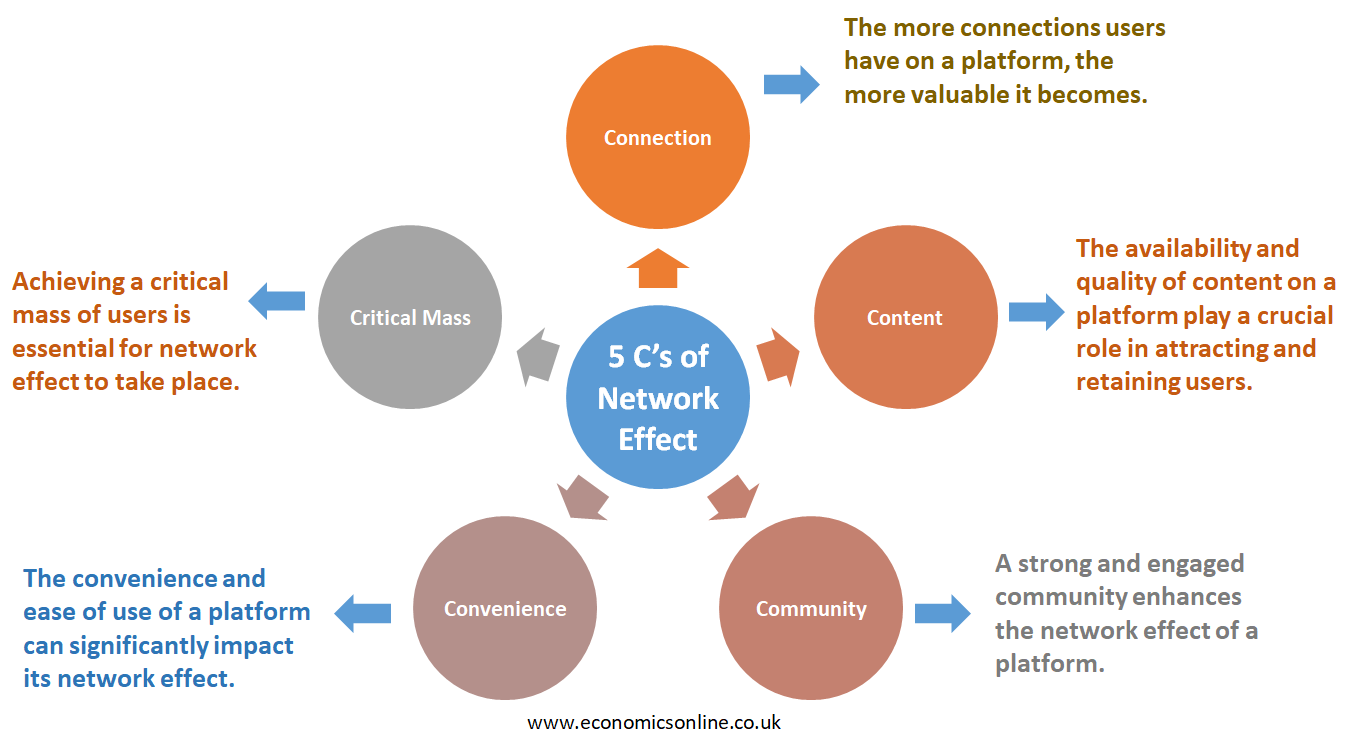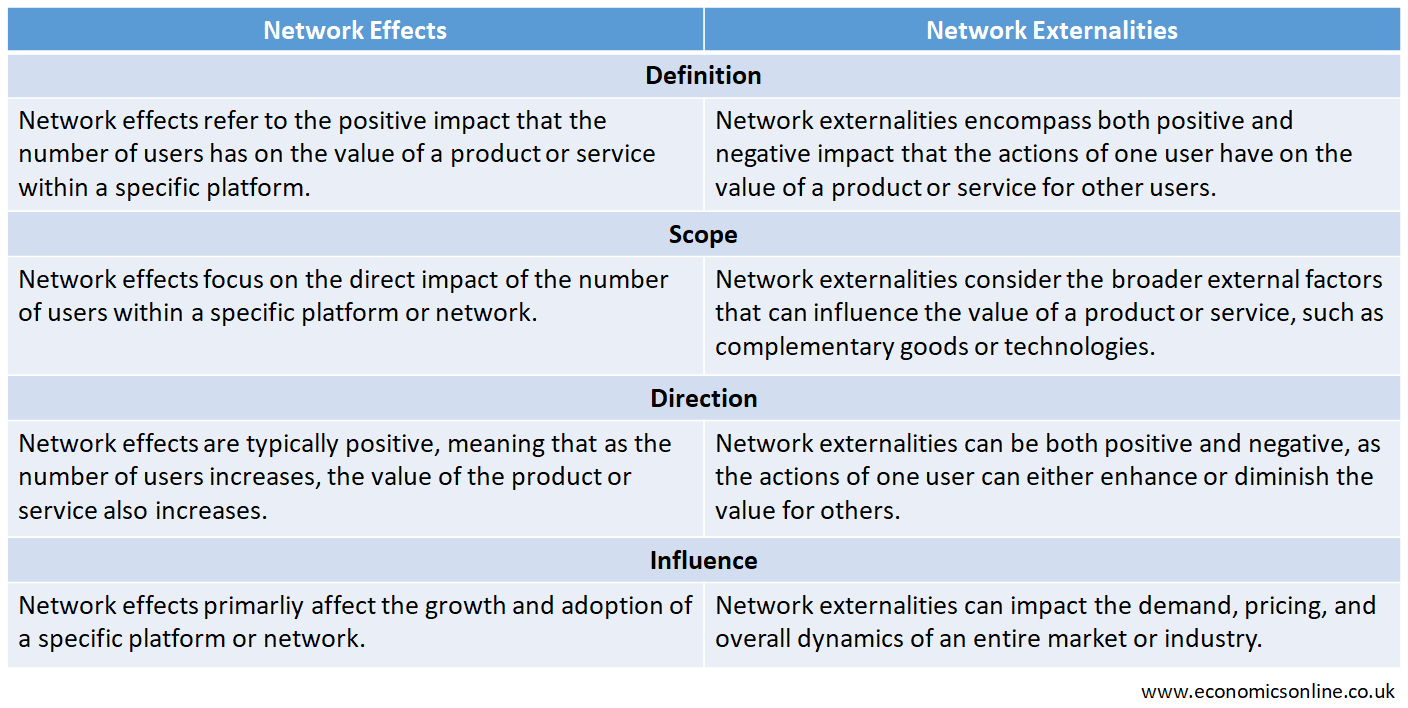
Network Effects: A Detailed Guide
What is a Network Effect?
A network effect refers to an increase in the importance or value of a product or service with an increase in the number of its users.
In simple words, network effects tell us that the value of a product or service is directly related to the number of users in a network. When the number of users increases, so does the value of a product or service.
In economics, the positive effect that a number of participants have on the importance of a product or service is known as the network effect. The network effect explains that as the number of users increases in a network, the value or importance of the products and services also increases in that same network.
History
The concept of the network effect has its roots in the late 19th century, with the invention of the telephone. Theodore Vail, who became the first president of Bell Telephone after its patents had expired, argued that Bell Telephone would enjoy a monopoly due to the network effect.
Subsequently, Robert Metcalfe, the innovative mind behind Ethernet, contributed to the popularisation of this notion by introducing Metcalfe's law. This law proposes that the worth of a telecommunications network is directly linked to the square of the number of users connected to it.
Fast forward to today, and we witness the network effect in action in various practical and tangible ways. This is evident in the success of social media giants such as Meta, X, and LinkedIn. In these cases, the more individuals who create accounts on these platforms, the greater the value, both for the users themselves and for the company's stakeholders.
The Working of the Network Effect
The working of the network effect is simple. For example, in the case of social media platforms, with every new user creating an account on a social media platform, it can lead to the creation of more content, leading to a better user experience and value creation for the existing user base, hence making it more valuable.
With the increase in the value of the platform, more people will create accounts, and the platform will grow exponentially.
This network effect was experienced by Facebook, X (former Twitter), Instagram, Pinterest, and other social media platforms.
Examples of the Network Effect
The following are some examples of network effects:
Telephone
The telephone network is an example of network effects. When the telephone was invented, it was a new thing for every person in this world. The telephone is used for communication and connectivity between people around the world. As more people owned telephones, the importance of telephones increased.
Social Media Platforms
Social media platforms such as Facebook, Instagram, Twitter, etc. took advantage of network effects. As the number of users on these social networks increases, more content will be shared between users, and the value of these social media platforms will increase.
Online Marketplaces
Online marketplaces such as Amazon, eBay, Shopify, etc. are examples of network effects. These online marketplaces create a strong connection between buyers and sellers by increasing the number of sellers. As the number of sellers increases, more products are available online for customers to buy. This increased the number of buyers as well.
Ride-Sharing Apps
Ride-sharing apps such as InDrive, Uber, Careem, etc. are examples of ride-sharing apps. These apps became popular due to the increase in the usage of mobile phones and other communication devices, including android and IOS devices.
Messaging Apps
The messaging apps such as WhatsApp, Facebook Messenger, Discord, etc. are examples of network effects as the number of users of these apps increases. The value of these messaging apps is increasing with the increase in the number of users, and they offers connectivity and communication between people around the globe.
The 5 C’s of Network Effect
The following diagram illustrates the five essential elements of a successful network effect.

Types of Network Effects
There are different types of network effects, which are explained below in order of strength:
Physical Network Effect
These occur when the value of a product or service increases as more people physically use it, like transportation systems. The landline telephone network is an example of physical network effect.
Protocol Network Effect
These happen when the value of a product or service increases as more people adopt a common protocol or standard, like the internet.
Personal Utility Network Effect
These occur when the value of a product or service increases for an individual as more people increase its usage, like social media platforms. WhatsApp, Messenger, iMessage are the examples of personal network effect.
Personal Network Effect
These happen when the value of a product or service increases for an individual based on their personal network connections, like professional networking platforms. LinkedIn is an example of personal network effects.
Market Network Effect
These occur when the value of a product or service increases as more buyers and sellers join a marketplace, like e-commerce platforms. HoneyBook and AngelList are the examples of market network effects.
Sources of Network Effects
The following are the sources of network effects:
Direct Network Effects
The direct network effect happens when the value of the products or services is directly proportional to the number of users or participants who use them. In this way, the value of the products or services increases as the number of users or participants increases. Direct network effects are also known as one-sided network effects.
Example
The social media platforms (Facebook, Snapchat) are the examples of direct network effect, in which the value of a platform increases as the number of users or connections increases by becoming friends on these platforms.
Indirect Network Effects
The indirect network effect happens when the value of products or services increases as complementary goods or services are freely available in the marketplaces.
Example
The value of a game console increases as more video game developers develop video games.
Two-sided Network Effects
When the value of the product or service (platform) totally depends on the communication between different user groups, this is known as a two-sided network effect.
Example
A connection between merchants and consumers through a credit card network is an example of two-sided network effects. The value for consumers rises as a greater number of merchants accept their credit card, and the value for merchants rises, as a greater number of consumers use the card.
Local Network Effects
Local network effects are those that consist of a specific geographic area or marketplace.
Example
A ride-sharing service app is an example of local network effects as more riders and drivers join the same platform in the same city.
Critical Mass
Critical mass refers to the point at which a network reaches a minimum number of users or participants needed to generate significant value and attract more users. Once critical mass is achieved, the network can experience rapid growth and adoption.
Example
In case of social media platforms, there is a critical mass of users required for the network to become valuable. When enough people are using a platform, it becomes more attractive to others, and the network effect helps it grow exponentially.
In addition to the factors mentioned above, the network size and network density also contribute to the success of a network.
Advantages of Network Effects
There are some advantages to network effects, which are:
Increased Value
As more users join a network, the value of the network increases for all participants. Think of social media platforms becoming more valuable as more friends join.
Enhanced User Experience
Network effects can lead to improved user experiences through increased interactions, content variety, and network effects-driven features.
Competitive Advantage
Networks with strong network effects can create barriers to entry, making it difficult for new competitors to gain traction.
Economies of Scale
As a network grows, it can benefit from economies of scale, leading to cost efficiencies and potentially lower prices for users.
Innovation and Collaboration
Network effects can foster innovation and collaboration among users as more users contribute ideas and resources to the network.
Disadvantages of Network Effects
There are some disadvantages to network effects, which are:
Monopolistic Tendencies
Strong network effects can lead to the dominance of a single network, potentially limiting competition and innovation.
Privacy Concerns
Networks with a large number of users may face challenges in ensuring user privacy and data protection.
Fragmentation
If multiple networks with network effects exist in the same space, it can lead to fragmentation and reduced interoperability.
Vulnerability to Negative Network Effects
While positive network effects can be beneficial, negative network effects can also occur, such as overcrowding, spam, or decreased user experience due to congestion.
Network Economics
The network effect is also known as network economics or network theory. Network economics is the branch of economics that deals with the behavior and working of networks.
Network economics is used to check how economic behavior is affected by various factors, such as network effects, network structure, and network development.
Network Effect as an Entry Barrier
Entry barriers are the hurdles faced by new firms when they try to enter a market. The network effect can serve as an entry barrier which makes it difficult to for new firms to enter an industry. This is due to the fact that the existing firms enjoy monopoly power due to the network effect. For example, WhatsApp is enjoying a huge network effect, giving it a monopoly power and making it difficult for new messaging apps to enter the market and compete with WhatsApp.
Negative Network Externalities
When the presence or usefulness of one product or service negatively affects the value, importance, or existence of a product or service for other users, this is known as negative network externalities.
Negative network externalities negatively affect some factors, such as reduced use of a relative product or service and the network used by the user. It also reduces the satisfaction of the user with a product or service.
Example
Traffic jams on crowded roads or overcrowded social media platforms are examples of negative network externalities.

Network Effect and Pricing Strategies
There are some pricing strategies that are used in the network effects, which are:
Freemium Models
Many platforms with strong network effects offer free access to their basic services, attracting a large user base. They then monetise through premium features or additional services.
Value-based Pricing
Companies with strong network effects often focus on pricing models that align with the value they provide to users. This can involve charging higher prices to users who derive more value from the network.
Subsidised Pricing
In some cases, tech companies may initially subsidise the cost of using their network to encourage adoption and rapid growth. They then adjust pricing strategies as the network matures.
Price Discrimination
Networks can employ price discrimination strategies, offering different pricing tiers or options based on user characteristics, usage patterns, or willingness to pay.
Conclusion
In conclusion, network effect is the phenomenon that plays a vital role in the success and growth of digital platforms. This leads to various benefits, including increased user acquisition, higher user engagement, monetisation opportunities, competitive advantage, and enhanced financial returns. Network effect tells us about the value of products or services in relation to the number of users.


